Celebrating Deutsche Bank’s 20 years as Global Lead Partner of Frieze art fairs with a series of 20 articles on 20 featured artists.
This article forms part of a special series celebrating Deutsche Bank’s 20 years as Global Lead Partner of Frieze art fairs, taking a closer look at 20 artists we have collaborated with and whose work features in the Deutsche Bank Collection.
-
Imran Qureshi: contemporary practice rooted in tradition
Imran Qureshi was Deutsche Bank's Artist of the Year in 2013. From an ancient art form, Moghul miniature painting, the Pakistani artist has created completely new ways of expression that address universal themes: Violence, suffering, spirituality - and the hope for more humane societies.
Imran Qureshi, Deutsche Bank's Artist of the Year 2013, comes from a country that has seen both, upheaval and turmoil: Pakistan is still torn apart by political and religious conflict, everyday violence, and corruption. But it is also a country on the move, drawing on a rich cultural tradition, where many people believe in a process of rethinking and a new, more tolerant society. Qureshi, born in 1972, is one of them. Trained in traditional Mughal miniature painting, he has developed entirely new means of expression from this ancient art form from the 16th century. In his works, which can be as small as a postcard or encompass entire building complexes, he has repeatedly addressed the social situation in Pakistan.
He came to international acclaim in 2011 with “Blessing Upon the Land of My Love”, the award-winning installation he created for the 10th Sharjah Biennial in the United Arab Emirates. Seen from above, the white-paved courtyard of the former Bait Al Serkal Hospital looked like the aftermath of a suicide bombing: an unimaginable explosion of dark red splashing over the walls of the building, dripping from ventilation shafts, pooling in dense puddles, trickling into the drain in the middle of the courtyard. On closer inspection, however, thousands of filigree blossoms materialised on the pavement, forming paths and islands in various ornaments and climbing up the building. The installation was created in response to a bomb attack on a busy square in the artist's home city of Lahore.
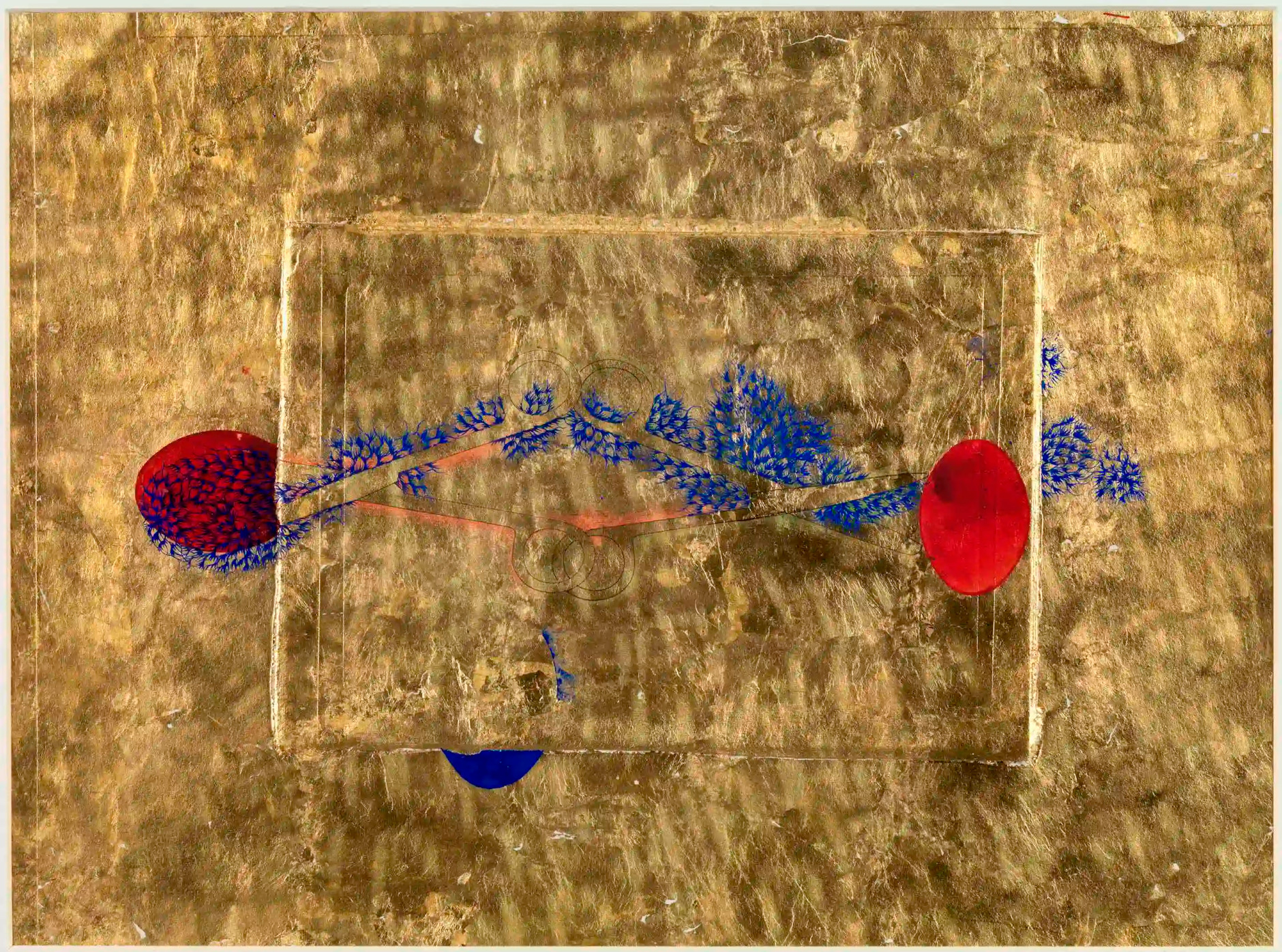
Imran Qureshi, 'Here and there', 2008, Gouache and gold leaf on wasli paper | Credits: Courtesy the Artist, Corvi-Mora, London and Galerie Thaddaeus Ropac, London, Paris, Salzburg
The colour red is a clear allusion to blood and the victims of violence, while Qureshi's floral motifs evoke the possibility of renewal and growth. For the artist, the flowers that emerge from the colour represent the hope that, despite the violence, people will maintain their belief in a better future.
There is something deeply spiritual and existential about Qureshi's hair-thin miniature paintings decorated with gold and flowers. They come from a very specific culture and history, from the artist's biography, but they embody universal questions. This is also the case in the small-scale painting “Here and There” (2008), covered in gold leaf, in which abstract forms symbolise a cosmic structure in which everything is interconnected and animated. Oval shapes also frequently appear, reminiscent of eggs, germ cells of new life, or protective shells in which fragile memories, thoughts or feelings are nurtured and incubated. "Here and There" embodies the unity of this life and the beyond, matter and transcendence, past and future.
-
Kandis Williams: history and struggle
Ornaments of violence and resistance: the collages of Los Angeles-based artist Kandis Williams look like Rorschach tests. But in fact, in the era of Black Lives Matter, they recall the racist traditions of the US and the ongoing struggle of the black civil rights movement.
Kandis Williams' artistic practice is extraordinarily diverse. It includes collage, performance, video, assemblage and installation. She also writes and publishes activist and academic texts through Cassandra Press, which she co-founded. Her work exposes the latently violent mechanisms to which the black body , and particularly the female black body is subjected. In doing so, Williams draws on discourses as diverse as psychoanalysis, critical race theory, semiotics and social psychology - as well as on subjects as diverse as botany, theatre and ballet. She has become one of the most important voices in the contemporary US art scene. In 2019, "The Oratory Command: X Carmichael King Hampton' (2016), a collage from her 'Disfiguring Traditions' series, was acquired for the Deutsche Bank Collection at Frieze LA.

Kandis Williams, 'The Oratory Command: X Carmichael King Hampton', 2016 | Credits: © Kandis Williams. Courtesy of Morán Morán.
The work looks like a Rorschach test. But it is actually composed of hand movements and gestures of famous black activists and civil rights campaigners, in this case the hands of Martin Luther King and Stokely Carmichael. For her series, Williams collected reproductions of hands from historical photographs: Malcolm X's rhetorically raised index finger, his open palm; Gloria Richardson's defiant thrust at a National Guardsman's bayonet, Dr Martin Luther King Jr's hands thrown up in surrender. These photocopied gestures are repeated in the shapes of crosses, grids, flowers and clouds, as if the viewer is looking into a kaleidoscope. Williams creates an ornament of violence and resistance, an equally poetic and analytic reflection of power and oppression. The photographs are historical. But the collage series subtly references the current political situation and systemic racism in the US, at a time when Black Lives Matter is becoming one of the most important activist movements of the present.
-
Anish Kapoor: adventures in space
Anish Kapoor's sculpture "Turning the World Upside Down III" has become the signature work of art at Deutsche Bank's UK headquarters in London. A brief excursion into the work of the artist, who creates color spaces out of pigment dust and renders tons of steel immaterial.
Along with Tony Cragg, Barry Flanagan, and Rachel Whiteread, Anish Kapoor is one of the artists from the Deutsche Bank Collection who revolutionized British sculpture in the early 1980s-with new materials such as plastics and pigments, with works that combine concept, poetry, and transcendence. Kapoor is not afraid of any dimension: His mirrored stainless -steel sculpture "Cloud Gate" (2006) in Chicago's Millennium Park weighs a whopping 110 tons. In 2002, he installed a blood-red membrane 155 meters long and 35 meters high in the Turbine Hall of the Tate Modern. His sculpture for the Deutsche Guggenheim, "Memory" (2008), commissioned by Deutsche Bank and the Guggenheim Museum, was also massive. Seamlessly, 154 elements of Cor-Ten steel fit together to form an organic form weighing 24 tons.
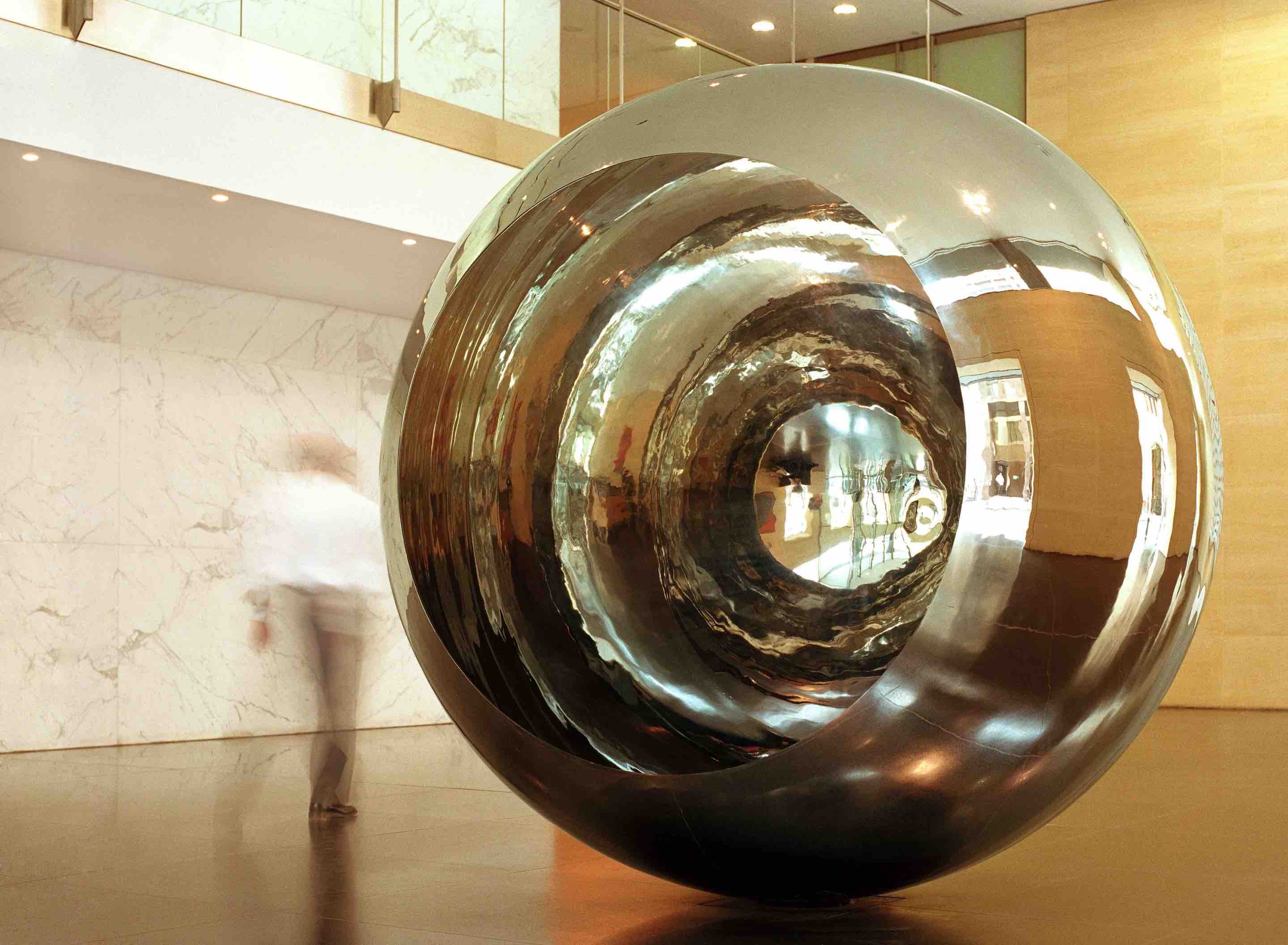
Anish Kapoor, 'Turning the World Upside Down III', 1996 © Anish Kapoor. All Rights Reserved, DACS 2023
The Indian-British artist, with whom Deutsche Bank hosted an exhibition at RIBA on the occasion of Frieze Art Fair in 2008, has numerous works in the Deutsche Bank Collection. For the company's employees, however, it is above all his steel sculpture "Turning the World Upside Down III" (1996) that has become a kind of landmark, welcoming visitors to the lobby of London's Winchester House since 1999 and will move to our new headquarters in Moorgate later this year. Like all of the Turner Prize-winning artist's work, it appears intriguingly immaterial, floating, seeming to change with each movement of the viewer, almost impossible to grasp. Kapoor creates spatial experiences that are both physical and metaphysical. His work thrives on the tension between form and formlessness. It is this enigmatic ambiguity that gives his works an almost spiritual quality. This is also true of his works on paper. His pigment gouache "Untitled"(2001) is completely abstract, non-objective. Yet it has the power of a romantic landscape painting - and appears to be an infinite space of color whose barely comprehensible depth is only hinted at by a blurred stripe of color.
-
Erin O'Keefe: spatial effects
People often talk about how a painting is 'constructed', but Erin O'Keefe's colourful, abstract still lifes are literally built.
Often mistaken for paintings, her works are in fact photographs, created by a practice encompassing architecture, model making and installation art. The pictorial space is a physical space in which O'Keefe arranges colourfully painted, carved or sawn geometric wooden shapes and panels, and then photographs them.
Born in 1963, O’Keefe, whose creations were shown in the exhibition 'Ways of Seeing Abstraction – Works from the Deutsche Bank Collection' at the PalaisPopulaire in Berlin in 2021 and to whom Deutsche Bank dedicated a solo presentation at its Frieze New York client lounge in 2022, has developed an art form all her own.
Inspired by perspectives spanning centuries
The step from three- to two-dimensionality, and the play with surface, colour and form, cleverly lead the viewer astray and trigger an array of associations. O'Keefe's images recall the abstract painting of classical modernism, cubism and surrealism. They have a playful, theatrical quality; a graphic, illustrative effect, giving the impression that the image has been reworked and manipulated, or created digitally. The combination of different art forms and techniques is inspired by the ideas of the Bauhaus, especially the colour theory of Josef Albers, which deals with the spatial effect of colour. At the same time, O'Keefe is fascinated by the deceptive spatial perspective of early Renaissance paintings.
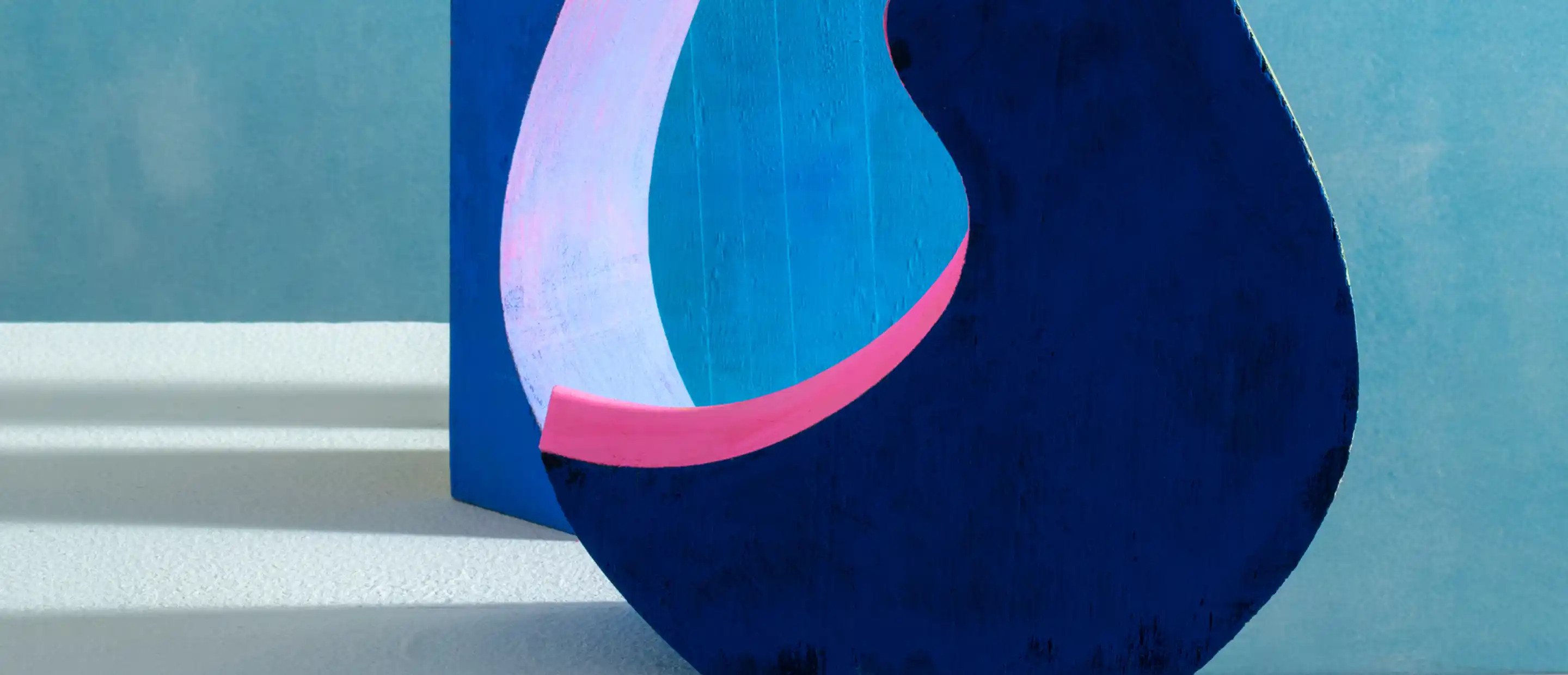
Left: Erin O’Keefe, 'Bluebell', 2021, Unique archival pigment print on Hahnemuhle Photo Rag mounted to aluminium © Courtesy of the artist and Seventeen Gallery, London | Right: Portrait Erin O’Keefe, Courtesy © Seventeen Gallery
Evolution from architect to artist
Her engagement with painting is closely linked to other disciplines. First, O'Keefe graduated from Cornell University with a degree in printmaking. She went on to earn a master's degree in architecture and taught for 23 years. During this time, she was already creating cubist-inspired sculptures in her New York studio, which she began to photograph – with such success that in 2014 she gave up her original profession and devoted herself entirely to her artistic career.
The sophistication she has developed in the process is evident in works such as 'Bluebell' (2021), in which O'Keefe models shape and colour in an almost musical interplay between sculpture and painting. But what looks so effortless is the result of long experimentation, as O'Keefe explains: "My studio process is quite open-ended, lots of trial and error. Small shifts or alignments in the still life can transform the reading of the image, and that moment feels like magic to me.”
Main image: Erin O’Keefe, 'Bluebell', 2021 (detail) Unique archival pigment print on Hahnemuhle Photo Rag mounted to aluminium © Courtesy of the artist and Seventeen Gallery, London
-
Lubaina Himid: art and activism
Born in 1954 on the East African island of Zanzibar, Lubaina Himid grew up in Britain, where she played an important role in the Black Arts Movement of the 1980s and 1990s. For a long time, she was known only to art insiders. That changed in 2017, when she became the first black woman to receive the Turner Prize.
While major themes such as slavery, racism, colonialism and the African diaspora form the historical background of Himid's work, her paintings, sculptures and installations often narrate episodes from everyday life. With their bright colours and graphic style, they recall both early Pop Art and the hand-painted shop signs of West Africa. At the same time, they refuse to accept the clichéd representation of black people in media and art. "I see myself as a painter, but also as an activist," Himid says.
The year before her Turner Prize win, the Deutsche Bank Collection acquired paintings on paper from Himid's series "Dreaming has a Share in History" (2016). In 2023, Himid's works from the Deutsche Bank Collection will be on view in the exhibition "The Struggle of Memory" at the PalaisPopulaire in Berlin. In the new UK headquarters of Deutsche Bank in London, a conference room will be dedicated to the artist.

Lubaina Himid, 'Dreaming has a Share in History', 2016, Acrylic and pencil on paper © Lubaina Himid. Courtesy of Hollybush Gardens
Reclaiming identities and reframing perspectives
The structure of the paintings is based on colourful cloths, the 'kangas', which are worn as skirts or dresses or draped over the body in many African countries. Typical of these cloths are ornamental frames with motifs such as palm trees or flowers that enclose symbolic texts, sayings, prayers or mottos.
Instead of the usual slogans, Himid uses quotes from activists and writers such as James Baldwin and Audre Lorde – or, in this case, the German philosopher and cultural critic Walter Benjamin (1892-1940) – on her kanga works. Himid symbolically framed his quote, "Dreaming has a share in history," with eggs from which something might hatch. This is to be understood as having a double meaning. Benjamin meant by "dreams" utopias, but also the monsters that the "sleep of reason" produces, the horrors of war, exploitation and fascism. Himid thus points to the opposite of dreaming: that we must stay awake or wake up, that we must pay attention – instead of sleeping through the history that is coming our way.
Main image: Lubaina Himid © Photo: Magda Stawarska
-
Teresa Margolles: reflecting marginalised communities
Born in Culiacán, Mexico in 1963, Teresa Margolles has always been intensely concerned with death – specifically with people who die as a result of poverty, violence, drugs and crime.
Trained as a photographer and forensic pathologist, she has worked in Mexico City's morgues, using water and linen cloths to clean and store corpses in her installations. Margolles is also an activist. Her often very physical and drastic works demand justice and collective memory for the marginalised victims of everyday violence in Mexico, which primarily affects women.
In 2017, Margolles visited Cúcuta, Colombia, where the Táchira River traces the country's border with Venezuela. Due to the extremely difficult economic and political situation in Venezuela, the region has become a smuggling zone for Venezuelans to obtain basic goods that are currently scarce in their country. "Carretilleros” [handcart porters] who have become "trocheras" [illegal trail guides], smuggle goods under the bridge across the border at great risk. In the dark, the women have to carry enormous loads, up to 60 kilograms on their backs. For "Carretilleras sobre el puente internacional Simón Bolivar," Teresa Margolles invited these women to pose on the bridge with their work tool, the wheelbarrow, to become visible and demonstrate their resilience.

Teresa Margolles, Carretilleras sobre el puente internacional Simón Bolivar, 2017 Digital print on Hahnemuhle Photo Rag paper © Courtesy of the artist and mor charpentier
Creating a fading monument for London’s Trafalgar Square
Margolles's solidarity also includes trans women. In 2024, she will create a sculpture for Trafalgar Square in London as part of the prestigious "Fourth Plinth" project. She has proposed a work that highlights the number of murders of trans people around the world. She sees her sculpture, with plaster casts of the faces of 850 trans people, most of whom are involved in sex work, as a "wall of resistance. Over time, the faces will weather and fade with the London weather, leaving behind "a kind of anti-monument," Margolles says.
Main image: Portrait Teresa Margolles, Courtesy © Rafael Burillo.
-
Kapwani Kiwanga: illuminating power structures
Based in Paris, Canadian artist Kapwani Kiwanga extends the practice of minimal and conceptual art for the digitised 21st century. Her abstract works often oscillate between image and object, responding to architectural and social spaces.
Born in 1978, the anthropologist and social scientist is now one of the most relevant artists of her generation. In her work, Kiwanga critically reflects on the legacy of modernism and the ideological role of institutions, art, design, and architecture. This is also the case in her work "Counter-Illumination #1" from the Deutsche Bank Collection, which was on view in the 2020 exhibition "Ways of Seeing Abstraction" at Berlin's PalaisPopulaire.
A white, twisted blind, a bench, a cube composed of different surfaces: transparent black, magenta, orange, a translucent grey, perhaps a pane of smoked glass. You don't know exactly what's in front or behind in this sophisticated arrangement; what's a "picture within a picture”. Then you realise that the whole construction is about seeing, about looking in and looking out, about privacy and publicity.
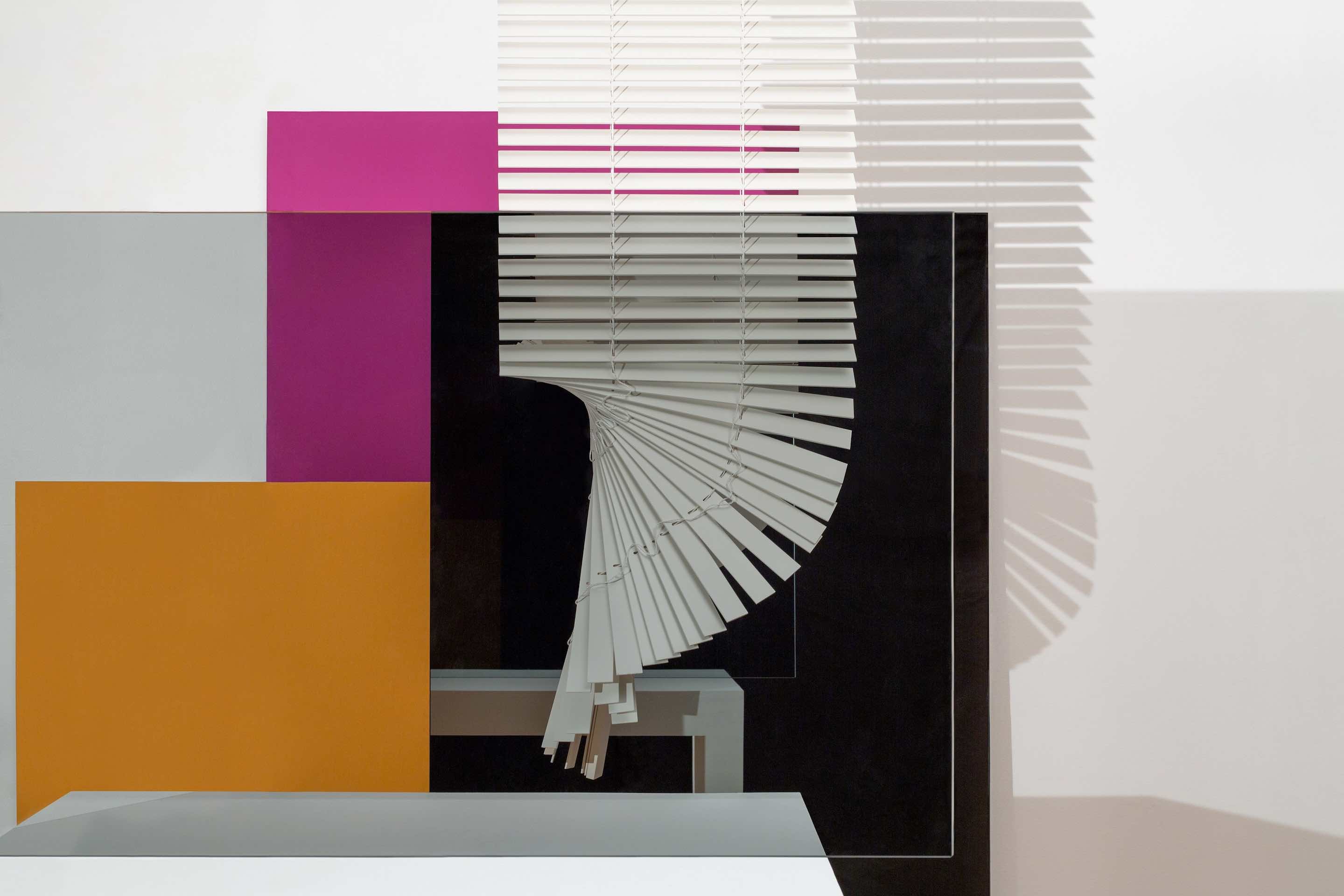
Kapwani Kiwanga, "Counter-Illumination #2", 2020 Digital photograph © Kapwani Kiwanga
"Counter-Illumination" is one of the studies for a huge, two-story photographic work conceived for the Dal Grauer Substation, a power substation in Vancouver, as part of the 2020 Capture Photography Festival. Fitting perfectly into the grid of the 1950s-era building's glass and steel façade, the enlarged photograph offered a glimpse that was as intimate as it was utterly constructed – and showed how abysmal the modern vision of public transparency and visibility has become in the age of digital surveillance and manipulation.
Main image: Portrait Kapwani Kiwanga, Courtesy © Bertille Chéret.
-
Idris Khan: layered with meaning
Idris Khan was born in Walsall, near Birmingham, in 1978, the son of a Welsh nurse and a surgeon of Pakistani origin. His work draws inspiration from literature, history, art, music, and religion, creating layered works with images, text, calligraphy, and musical scores that condense form and colour to create a ghost of the image or meditative abstractions.
In his artistic practice, Khan combines the history of painting in post-war modernism, the notions of Minimal and Conceptual Art, and the influences of Islamic and Far Eastern spirituality. This is evident in his Koran paintings, his Sufi-inspired philosophical-mystical stamp paintings, and his ongoing exploration of calligraphy and meditative repetition.
His photographic and video works, sculptures, and works on paper and glass reflect on transience, memory, philosophical, and theoretical ideas and often have a social or political background, dealing with migration, cultural identity, trauma, and loss.
Idris Khan and Deutsche Bank
Khan is represented in the Deutsche Bank Collection with numerous important works. These include a large site-specific work in the entrance of Deutsche Bank's Birmingham office and a commissioned work for the lobby area of the bank's Americas' headquarters at Columbus Circle, New York. In 2021, his work was presented in the Deutsche Bank Wealth Management Lounge at Frieze London. The previous year, he was the first artist to design a unique facemask in support of the Frieze x Deutsche Bank Emerging Curators Fellowship which encourages diversity in museums and galleries.

Idris Khan, "The Four Seasons", 2021, Oil and water-based inks on paper and collage mounted onto dibond © Idris Khan.
Main image: Portrait Idris Khan, 2022, Idris Khan.
-
Lada Nakonechna: between information and propaganda
In her drawings and collages, Ukrainian artist Lada Nakonechna deals with the situation in her homeland and the ideological power of images that tell of war. Today, her work is more urgent than ever.
The artist, who lives in Kyiv, deals with the political situation in her home country in her work. She is particularly interested in the power and manipulation of images, their ideological context, and the difference between information and propaganda.
As early as 2014, shortly after the mass protests on the Maidan, Kyiv's central square, a series of Nakonechna's drawings was purchased for the Deutsche Bank Collection. In 2018, her works were shown in the collection exhibition "World on Paper" at the PalaisPopulaire in Berlin.

Lada Nakonecha, “Merge visible. Composition number 43, 2016”, Photography, cut out, pencil © Courtesy of the artist and Galerie EIGEN + ART Leipzig/Berlin
Work that aims to expand the viewer’s critical apparatus
It is always landscapes or architecture that Nakonechna works with in her installations, videos, performances, pencil drawings or collages. As she puts it, she wants to expand the viewer's "conceptual apparatus" and make them aware of how political events, wars and violence inscribe themselves in reality, its images and our perception.
A good example of this is her 2016 work "Merge visible. Composition number 43”, which is part of an extensive series. At first glance, the collage looks like an abstract, constructivist composition. But it is actually made up of fragments of photographs that Nakonechna collected online. They all show bombed-out, burnt-down buildings from the war zones of eastern Ukraine. "Merge visible" is a Photoshop function that allows you to merge all visible layers into one. With this in mind, Nakonechna began to cut out by hand with a scalpel everything from the printed image that had been burned or destroyed. All that remained were fragments, sometimes just lines.
These collages subtly allude to Suprematism, the Russian avant-garde movement of the early 20th century that sought to use geometric abstraction to convey three-dimensionality and movement, which was a new, transcendent way of thinking for a new society. In contrast, Nakonechna's thinking, like the scalpel in her hand, follows the path of destruction, erasure and trauma. Metaphorically, she tries to save what she can but in doing so she also reveals the loss, the gaps in memory – a wholeness that is lost forever.
Main image: Lada Nakonecha, “Merge visible. Composition number 43, 2016”, Photography, cut out, pencil © Courtesy of the artist and Galerie EIGEN + ART Leipzig/Berlin
-
Sir John Akomfrah: creating new narratives from history and memory
Sir John Akomfrah is one of the most important British artists working today. Akomfrah was a founding member of the influential Black Audio Film Collective, formed in London in 1982, alongside artists David Lawson and Lina Gopaul, with whom he still collaborates.
Akomfrah has spent decades developing a multi-layered visual language. His films combine archival footage, still photographs, newly shot material, and newsreels to create complex cinematic essays. He gained recognition in 2012 for his three-screen installation "The Unfinished Conversation" (2012), a moving portrait of the life and work of cultural theorist Stuart Hall. In his three-screen film installation "Vertigo Sea" (2015), he focused on the disorder and cruelty of the whaling industry, juxtaposing it with scenes of many generations of migrants making epic ocean crossings in search of a better life. In 2017, Akomfrah presented his largest film installation to date, “Purple”, which explores climate change, human communities, and wilderness.
In 2017 Akomfrah was awarded the prestigious Artes Mundi Prize. He has had numerous solo exhibitions at venues including Secession, Vienna, Austria (2020); ICA Boston, MA, USA (2019); New Museum, New York, NY, USA (2018); Museo Nacional Thyssen-Bornemisza, Madrid, Spain (2018); Barbican, London, UK (2017); Tate Britain, London, UK (2013-14); and MoMA, New York, USA (2011).
 John Akomfrah, The Liminality Triptych, 2016, C-type photograph
John Akomfrah, The Liminality Triptych, 2016, C-type photograph
© Smoking Dogs Films, All Rights Reserved, DACS 2022 and for Artimage requests: © Smoking Dogs Films, All Rights Reserved, DACS/Artimage 2022. Courtesy Lisson Gallery 2023.Sir John Akomfrah and Deutsche Bank
Deutsche Bank began acquiring Akomfrah's work in 2016. The relationship deepened the following year, when his work was featured in the Deutsche Bank Wealth Management Lounge at Frieze London. The lounge exhibition included new photography and the film "Auto Da Fé," which won the Artes Mundi. In his epic photo and video work "Liminality" (2017), the landscape plays a central role. In this work, Akomfrah explores the historical, economic and environmental impact of colonialism, allowing geological and human time to collide. The complex, intertwined relationship between humanity's destruction of the natural world and the self-destruction of our civilisation has remained a central theme in his later work, including “Four Nocturnes” (2019).
He was awarded a knighthood for services to the arts in the 2023 New Year Honours and will represent Britain at the Venice Biennale in 2024.
Main Image: John Akomfrah, 2023 © British Council. Photography by Taran Wilkhu.
-
Victoria Fu: blurring visual boundaries
Victoria Fu's works are meditations on vision, perception and the creation of images. Born in 1978 and based in San Diego, California, Fu's installations combine photography, video screens, mirrors, light projections and neon to create an interplay between objects, moving and still images. Fu uses clips from the internet, 16mm film, and digital video footage, which she edits with visual effects in post-production.
Often interacting with the surrounding architecture, her work questions our notions of what is "real" and "artificial" and explores the cultural and psychological spaces created by the virtualisation of the world – and how this changes the human experience. "Post-cinema" is a term that is often mentioned in connection with Fu's work. It refers to the expansion of the traditional cinematic experience into an immersive one in which there are no longer clear boundaries between viewer, medium, and "image".
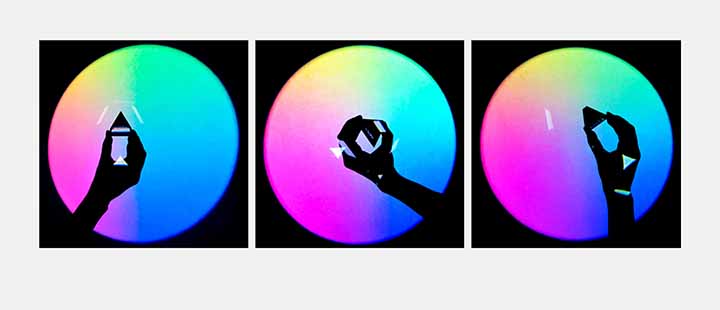
Victoria Fu, "Circle Prism 1-3", 2017, Archival inkjet print © Victoria Fu
Combining light art and cutting-edge technology
Fu's artistic practice follows in the tradition of California artists such as James Turrell, Robert Irwin, Ed Ruscha, and Diana Thater. In 2019, she was invited to create an exhibition in the Deutsche Bank Wealth Management Lounge for the first edition of Frieze Los Angeles. Responding to the architecture of the lobby of the Paramount Theatre, she developed a multimedia installation that explores the circle as an architectural motif and plays with light elements and projections. Similar to her 2017 lithography series "Circle Prism 1-3", the work creates an experience that oscillates between abstraction and representation.
Main image: Victoria Fu, "Circle Prism 1-3", 2017, Archival inkjet print © Victoria Fu
-
Caline Aoun: materialising the digital
Born in Beirut in 1983, Caline Aoun is part of a generation of young Lebanese artists who are shaping the scene in the Middle East today. In 2018, she was named Deutsche Bank's "Artist of the Year".
Today, we take it for granted that we use Google Maps, visit dating sites, or store our pictures in the cloud: the global flow of data shapes not only our everyday lives and relationships, but entire social systems. Yet the digital transfer of data is barely tangible to us; an abstract, "invisible" process.
In her work, Aoun explores the connections between digital data streams and the material world, which we are increasingly aware of today in the form of collapsing supply chains or breakdowns in local transportation.
Aoun translates phenomena such as excessive abundance, scarcity, circulation, and accumulation into abstract, minimalist art. She works with ordinary inkjet printers that she manipulates, overloading them with data or paper until the system collapses and "involuntarily" produces abstract images. This is the case in her work "Cyan, 4 Hours 10 Minutes and 9 Seconds" (2021). As the title suggests, the image is created by constantly overprinting the monochrome colour cyan over the course of four hours. The paper is covered with traces of the printing process, folds and streaks, painterly mechanical gestures that make the physical process of data transfer sensual and visible.
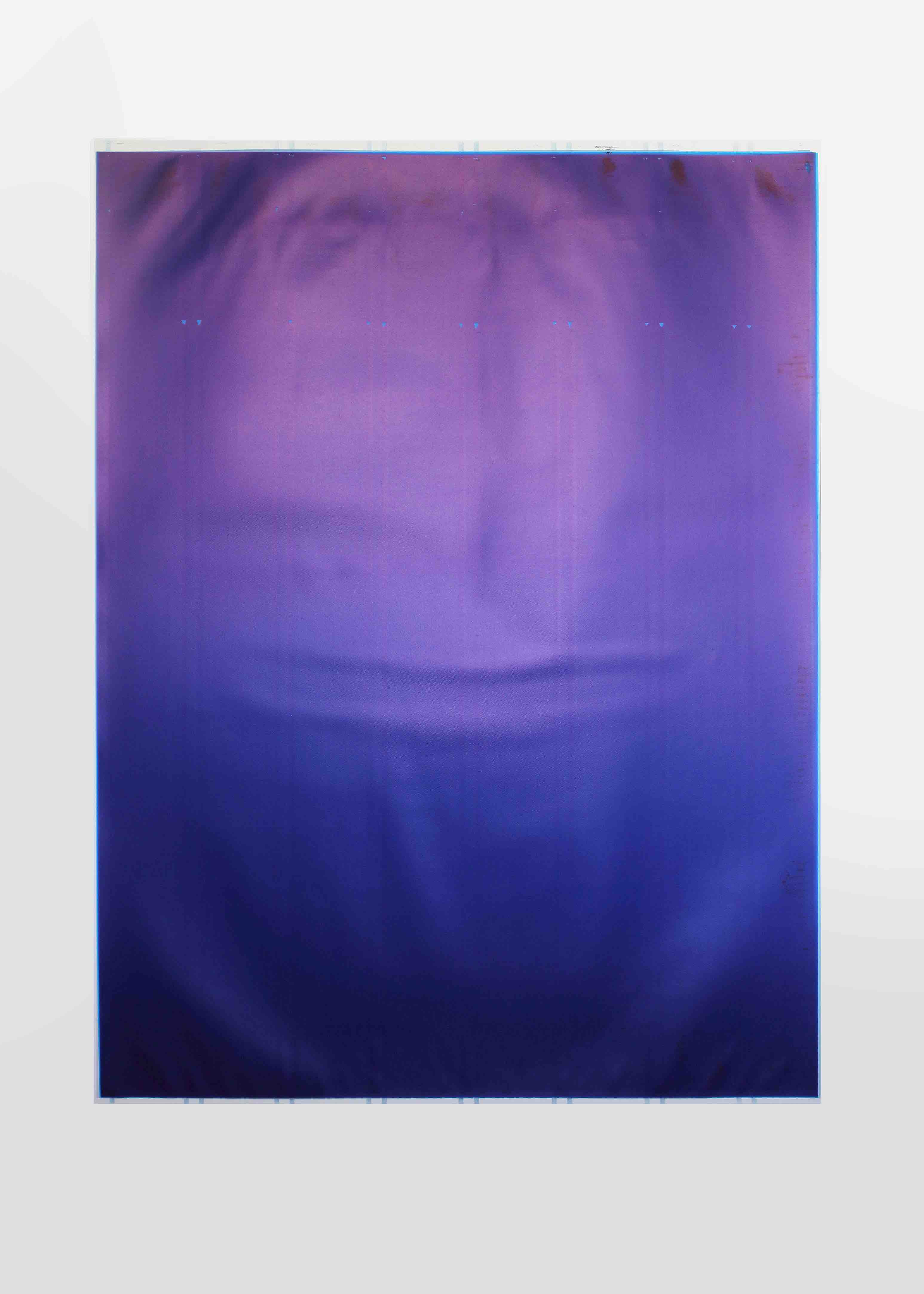
Caline Aoun, "Cyan, 4 Hours 10 Minutes and 9 seconds", 2021, Unique inkjet print on Somerset paper © Caline Aoun, courtesy Marfa’projects sal
Aoun also assembles huge, colourful, luminous wall works from sheets of A3 paper produced by manipulated printers, reminiscent of church windows. She creates fountains, connected by a system of tubes, from which colourful printer ink initially gushes, but over time increasingly mixes and dries into a black broth. She collects data from the harbour in her hometown of Beirut and uses it to create diagrams that look like abstract mountain landscapes. The parallels with the global economy, with ideological, political and economic conflicts in the digital age, are always present in these works.
For her exhibition Seeing is Believing at the PalaisPopulaire in Berlin, she even installed a livestream that transmitted images from the port of Beirut into the exhibition. Aoun’s work refers to the idea that data circulates like water, and focuses on issues like pollution of the sea and the migration crisis. The live stream also shows in an almost visionary way how closely art and daily political reality are intertwined. Just a few months after the show ended, on August 4, 2020, a catastrophic explosion destroyed large parts of the harbour and increased the major economic and political crisis in Lebanon.
For Aoun, the constant flood of images and data is like a "noise" that dominates our entire lives. Rather than amplifying this media noise, she concentrates it in her meditative works and gives it a material dimension. In this way, she aims to create new experiences, forms of visual "silence" that make it possible to comprehend and rethink contexts that are otherwise difficult to grasp.
Main image: Caline Aoun (detail) © Cherine Karam
-
Jose Dávila: leading excursions into modernism
For more than two decades, Mexican artist Jose Dávila, born in 1974, has been exploring the legacy of geometric abstraction, constructivism and minimal art. Drawing on artists and architects such as Luis Barragán, Josef Albers, Donald Judd, Richard Serra and Tony Smith, his work is both a critique of and an homage to the avant-garde art and architecture of the 20th century.
His sculptures, installations and photographic works are always characterised by a tension between opposing forces. Dávila, who studied architecture, creates sculptures that incorporate principles of design and physics as well as references to art history. He uses unconventional, organic, or industrial materials that he strings together, stacks, stretches or balances. He also creates forms into which he cuts geometric voids – always with a hint of humour and melancholy. For example, in his untitled series of 2018, which was acquired for the Deutsche Bank Collection at Frieze New York in 2022, the contours of neon works by the American light artist Dan Flavin appear as cut-out spaces.
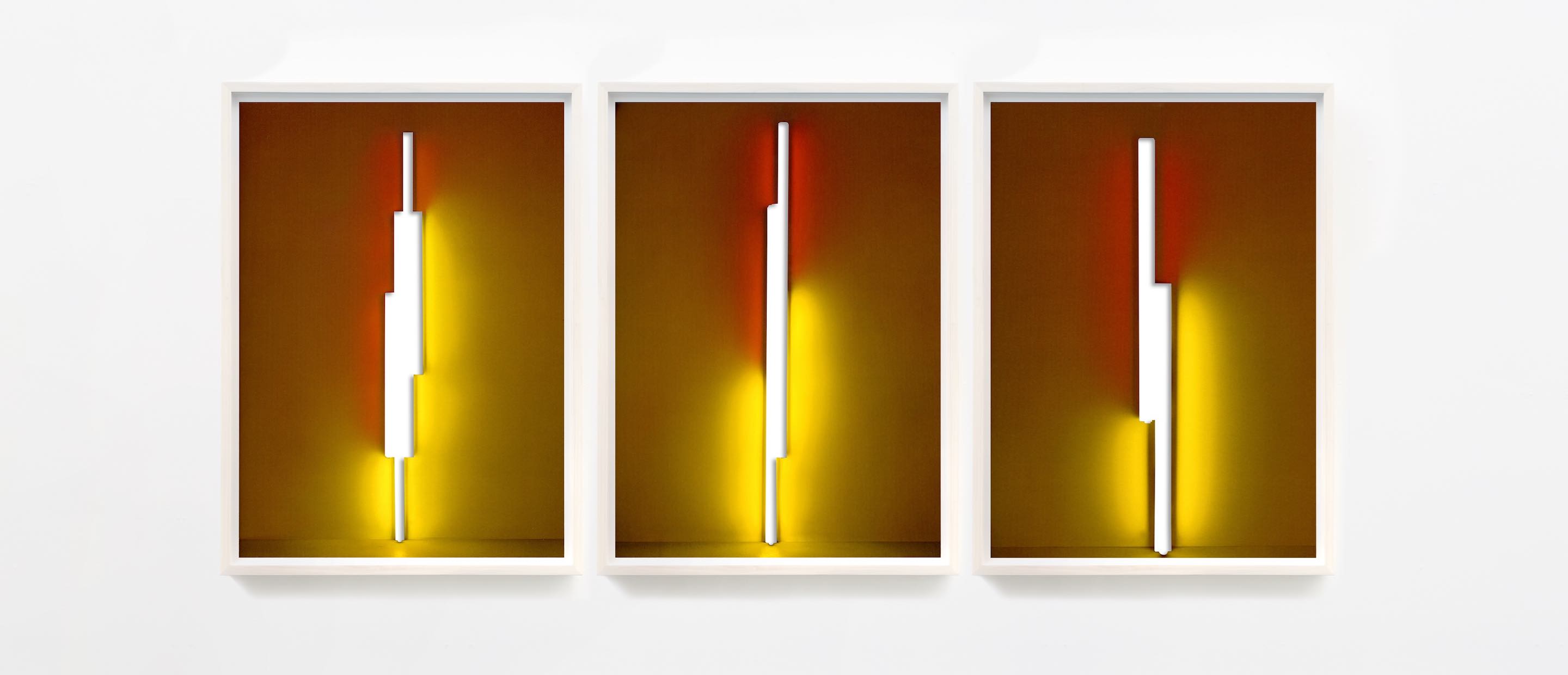
Jose Dávila, Untitled, 2018. Set of 3 archival pigment prints
© Jose Dávila, Courtesy: Sean KellyExploring how modernism still shapes our worldview
He also explores how non-objective, geometric abstraction has shaped public spaces and our perception; how modernist movements have been translated, appropriated and repeatedly reinvented, or even forgotten. His work often appropriates or interprets famous sculptures or architecture. In 2016, for example, he referenced and "deconstructed" Max Bill's marble sculpture "Kontinuität" (Continuity) in front of the Deutsche Bank Towers in Frankfurt with his work "Principle of Understanding", which consists of two interlocking "circles".
Dávila, who studied architecture, is interested not only in formal issues but also in the environments in which iconic modern artworks are installed. In some of his earlier works, he appropriated forms and ideas only to vary and develop them. In his more recent works, one sees a renaissance of sculptural possibilities, reflected and reimplemented in a very contemporary way.
Main image: Jose Dávila Portrait © Agustín Arce, Courtesy: Sean Kelly
-
Sarnath Banerjee: exploring the art of storytelling
Sarnath Banerjee, born in Kolkata in 1972, is an Indian graphic novelist, illustrator and publisher. After studying visual communication at Goldsmiths College in London, he published his first book, Corridor, in 2004. It is considered one of the first Indian graphic novels and brought the artist, who now lives in Berlin, international recognition.
As in his later works, the graphic novel explores stereotypes, myths, and morality in contemporary India and the postcolonial world. At the same time, Banerjee's work is characterised by a whimsical, melancholic humor and a poetic critique of the mechanisms of power.
In 2016, his project "An Encounter with Thomas Browne and other Commonplace Utopia" transformed Deutsche Bank's Canary Wharf office into a walk-in book with 80 large-scale artworks. For each of the eleven floors, he developed a series of individual images or short sequences that were transferred to large-format wallpaper. Accentuated with few colours, they are comic-like drawings with pointed texts and a lot of absurd humour. A structure of independent but interconnected episodes unfolds across the floors.
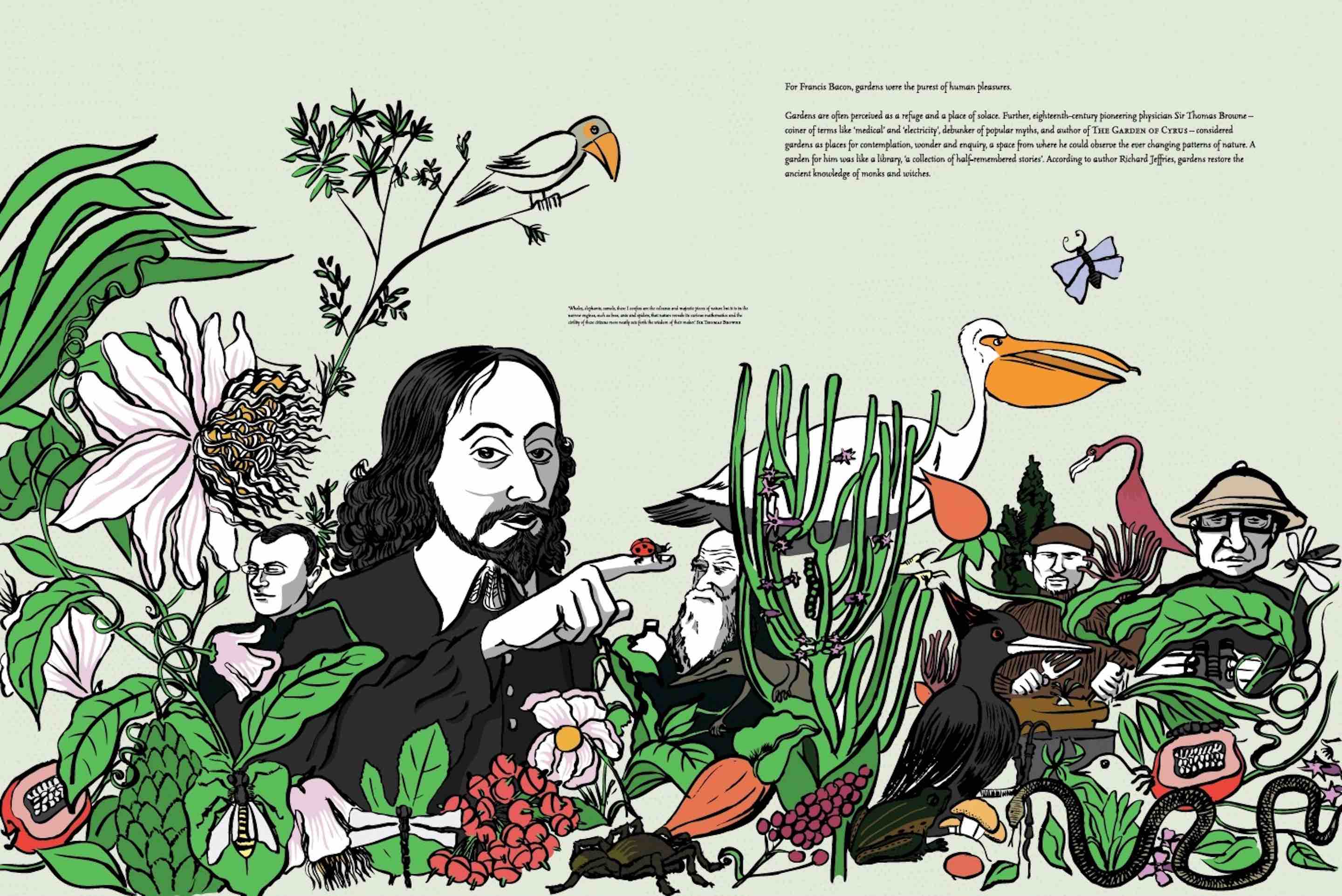
An Encounter with Sir Thomas Browne and Other Commonplace Utopia, 2016 | Wallpaper installation; printed onto rafa canvas © Sarnath Banerjee
How Banerjee’s work drew inspiration from centuries of literature
Banerjee's favourite authors include Fernando Pessoa, Jonathan Swift, and Robert Walser. Literature and books are ever-present in his work. "An Encounter with Thomas Browne and other Commonplace Utopias" is therefore also a journey through more than a thousand years of literary history – from al-Kindi, who introduced the Islamic world to the writings of Aristotle and Plato in Baghdad in the 9th century, to J.A. Baker, who in the 1960s in Essex pursued a very British passion for bird-watching.
The British philosopher and poet Sir Thomas Browne (1605-1682), who inspired Banerjee's vast body of work for Deutsche Bank, was a polymath who explored science and medicine as well as religion and esotericism. He also enriched the English language with hundreds of new words such as computer, electricity, hallucination, medical, suicide and therapeutic. The commissioned work was not only inspired by Banerjee's reading and everyday observations while travelling but also emerged from a dialogue with Deutsche Bank staff, with whom he discussed places of retreat. This led to several drawings of gardens by Banerjee, who is concerned with the idea of a private Arcadia, its cultural or social aspects, and the growth and cultivation of ideas.
Historical illustrations intended to guide and inspire
On the 10th floor of the building, staff and visitors encountered various episodes on the theme of "Walking". The artist had various figures from cultural history appear here: Gandhi and Badshah Khan marching together for peace, or the philosopher and flaneur Walter Benjamin. "The people in the drawings,” says Banerjee, “are like Sherpas who take you to another thought process.”
Main image: Sarnath Banerjee © Roanna Rahman
-
Charles Avery: charting an imagined world
In 2004, Charles Avery began what was to become a lifelong project, "The Islanders", a meticulous, penetrating examination of the structure and possibilities of another place. In drawings, texts, and objects, Avery describes the inhabitants, architecture, philosophies, customs, and idiosyncrasies of this imaginary territory.
Charles Avery's nameless island is reminiscent of the Scottish Hebrides, but also of East London. Yet it is not really an island at all, but part of a self-contained universe, "in the midst of an archipelago of innumerable components". It's populated by humans, fallen gods, and an undefined species called If'fen.
The capital of his island is the port-town of Onomatopoeia: originally a starting point for pioneers and travellers, then a bustling boomtown, then a citadel, then a depression-ravaged slum, and finally a renewed cultural city. Avery documents the many eras it has lived through with architecture, sculptures, writings and myths. There is something nightmarish about the scenes of everyday urban life that he depicts in his ongoing work. Creepy plants, fantastic monstrous creatures, terrible taxidermy and strange machines are commonplace in shops, museums and public spaces.

Charles Avery, Untitled, from “That that dogs don’t know they know”, 2000 © Charles Avery. All Rights Reserved, DACS 2023.
Social life follows strange rules: squares are forbidden. The islanders avoid the number four and use a different counting system. They don't like rectangles or right angles. They do not drink from glasses, but from curved, tubular vessels that look like a cross between diving birds with long beaks and abstract sculptures. At the same time, there are echoes of post-war London, the culture of the 1970s and 1980s in which the artist grew up. Avery's eclectic worlds were ahead of their time precisely because they avoided spectacle. Their hybrid combination of different eras, cultures, religions, and systems of thought with the everyday world is reminiscent of current science fiction and fantasy series.Charles Avery divides his work into two areas: atomic and mystical. His "atomic" works are abstract and geometric, while his "mystical" works consist of figurative pencil drawings. He exhibits both areas together to explore questions of metaphysics, mathematics, and philosophy. He is particularly interested in the work of the philosopher Ludwig Wittgenstein, from whom he took the idea of an atomistic and mystical approach to art.
Main image: Charles Avery Charles Avery Portrait 2015 (detail) © Berta De La Rosa
